This month we highlight 12 nonfiction titles for a variety of ages. Some are novel in their approach to conveying information, while others inspire by exquisite writing, sound reasoning, or well-balanced visual design and historical retelling.
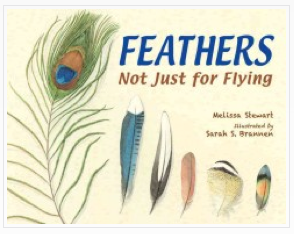 Feathers: Not Just for Flying
Feathers: Not Just for Flying
by Melissa Stewart, illustrated by Sarah S. Brannen
(Random House, 2014)
Publisher Summary Young naturalists meet sixteen birds in this elegant introduction to the many uses of feathers. A concise main text highlights how feathers are not just for flying. More curious readers are invited to explore informative sidebars, which underscore specific ways each bird uses its feathers for a variety of practical purposes. A scrapbook design showcases life-size feather illustrations.
Make Way for Books This is nonfiction at its finest. With such lifelike illustrations, there is little doubt readers would recognize these feathers on a nature walk. Brief, handwritten descriptions of each feathered creature convey the feel of a field journal, personalizing the reading experience and adding depth to each simile that describes a feather’s purpose. It took a few years and many drafts before Melissa Stewart “latched onto the idea to compare feathers to common objects in our lives.” The result is a tightly knit summary spread by spread that is gentle, informative, and somehow a little more extraordinary.
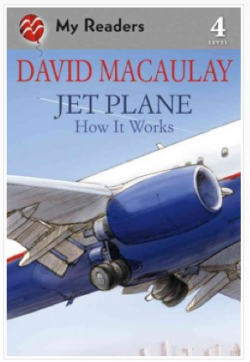 Jet Plane: How It Works
Jet Plane: How It Works
by David Macaulay
(Henry Holt, 2012 – new edition coming April 2015)
Publisher Summary Go on an airplane ride. It weighs as much as 100 elephants, but it can fly for hours. How does a jet do that? From the engine that provides the power and wings that lift the plane off the ground to the cockpit controls and passenger cabin, see how these modern marvels work and what makes them stay in the air. The Caldecott Medal-winning creator of The Way Things Work presents a fact-filled, visual profile of the jet plane that details its modern workings and scientific principles.
Make Way for Books Macaulay invites readers to enjoy a flight, then shows and describes the plane’s behavior on takeoff, during flight, and landing. His masterful drawings include just enough detail to clearly illustrate difficult concepts. He adds visual metaphor to strengthen his points, and uses angles and cross sections to reveal unique plane parts and systems associated with an everyday flight. Macaulay makes learning fun and fascinating.
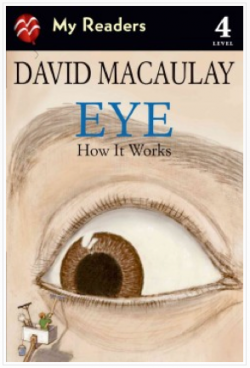 Eye: How It Works
Eye: How It Works
by David Macaulay
(Henry Holt, 2012 – new edition coming April 2015)
Publisher Summary How can you see that your shirt is on inside out? How do you see the soccer ball coming right at you? How do you know which players are on your team? It all starts with light, and with the amazing human eye. With his unique blend of informative text and illustration, David Macaulay shows how the anatomy of this extraordinary organ works to capture light and send signals to our brains.
Make Way for Books Macaulay’s clever way of showing the eye and its parts and telling its purpose by including it as an active “player” in the story’s unfolding soccer match, provides a rich, multi-sensory reading experience. By the story’s end, readers can more fully appreciate this organ’s importance and its multi-layered protective construction. An effective primer.
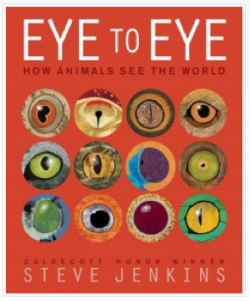 Eye to Eye: How Animals See the World
Eye to Eye: How Animals See the World
by Steve Jenkins
(Houghton Mifflin Harcourt, 2014)
Publisher Summary In his latest eye-popping work of picture book nonfiction, the Caldecott Honor–winning author-illustrator Steve Jenkins explains how for most animals, eyes are the most important source of information about the world in a biological sense. The Caldecott Honor-winning creator of What Do You Do with a Tail Like This? artistically profiles a series of animals with unusual eyes, explaining how such animals use their [unique] eyes to gain essential information about the biological world.
Make Way for Books Steve Jenkins is a master of details and perspective in a world of cut-paper illustration. While his art mesmerizes, page after page, satiating the most curious observer, the same attention is given to brief explanations that inform often by using comparisons. There is mention of eyes evolving over millions and billions of years, yet the focus is squarely on the stunning eyes of these lesser-known creatures—their uses and characteristics. A breathtaking celebration of unique creations.
Pair this with David Macaulay’s Eye: How It Works for a fascinating comparison/contrast study.
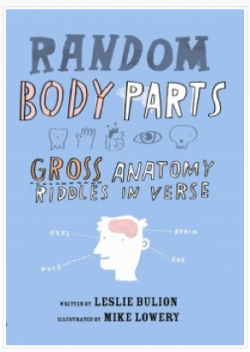 Random Body Parts: Gross Anatomy Riddles in Verse
Random Body Parts: Gross Anatomy Riddles in Verse
by Leslie Bulion, illustrated by Mike Lowery
(Peachtree, 2015 – available early March)
Publisher Summary Witty and nimble verse about body parts pairs with whimsical drawings in this informative, fun-filled collection. It begins with an invitation to solve a series of poetic riddles. Each poem that follows poses a puzzle in verse (with a sly wink and a nod to Shakespeare) and provides hints for uncovering the body part in question. Sidebars further educate readers about the anatomical subject in question, while appended notes offer a crash course on poetic form and a few facts about the Shakespearean works that inspired the verses. A glossary for science terms is included in the back matter.
Make Way for Books This book was a brave undertaking; it is an anatomy reference guide illustrated by layers of photographs and child-like drawings, and explained by concise conversational-styled encyclopedic entries that are retold in poetic formats—in the style of Shakespeare’s works. Although an initial read could construe it as too ambitious, the cleverness makes it the perfect book for writing instruction (and science too). There is a plethora of figurative language used to describe the design and use of various body parts. Engage readers in creating a similar description activity to appreciate the challenge this author-illustrator team tackled. Both entertaining and educational.
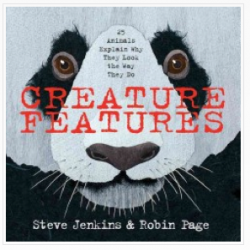 Creature Features: 25 Animals Explain Why They Look the Way They Do
Creature Features: 25 Animals Explain Why They Look the Way They Do
by Steve Jenkins and Robin Page
(Houghton Mifflin Harcourt, 2014)
Publisher Summary The Caldecott Honor-winning duo get face-to-face with unique animals from around the world in this playful exploration of unusual animal facial features.
Dear axolotl: Why do you have feathers growing out of your head? Axolotl: They aren’t feathers—they’re gills! They let me breathe underwater.
Packed with many cool facts and visuals on where certain animals live and what they eat, this book captures twenty-five humorous—and very true—explanations of why animals look the way they do in order to exist in this world.
Make Way for Books With creature names like “star-nosed mole,” “harpy eagle,” and “shoebill stork,” intrigue begins at page one. This talented author/illustrator duo introduces one animal at a time, close-up, asking one question that every reader would ask based on colorful, textured, paper-cut illustrations that cleverly-highlight a peculiar feature. Conversational, one to three-sentence answers satisfy curiosity and are supplemented by a well-rendered graphic on the closing pages. Silhouettes of every animal—proportionately-sized side-by-side—along with keyhole-sized maps displaying habitats help readers grasp large-scale context. Masterful nonfiction.
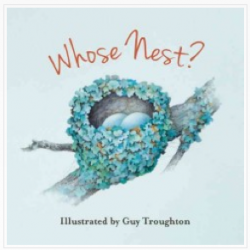 Whose Nest?
Whose Nest?
by Victoria Cochrane, illustrated by Guy Troughton
(PGW, 2013)
Publisher Summary Can you guess whose nest? Take a peek into the nest and look at the clues that surround it—a feather, a footprint, a tasty food morsel—and guess whose nest. Then turn the page to find out who really lives there. The animals include: dormouse, tree frog, clownfish, eagle, rabbit, mallard duckling, bumblebee, and gecko.
Make Way for Books Rich watercolor illustrations entice young book lovers to this interactive, lift-the-flap book. There is no gimmick here; each spread presents a simple riddle that describes an animal’s home. Rich vocabulary—I weave my secret nest…honeysuckle tree…oval hideaway…I nibble sweet berries and gnaw on hazelnuts—delights and inspires inquiry. The text requires a young nature lover to connect his experience with contextual clues in order to predict the creature’s identity. Lifting the flap to reveal the answer is a simple reward, yet completely engaging.
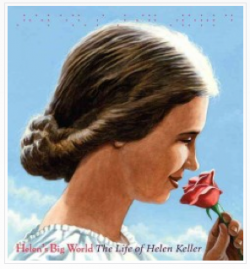 Helen’s Big World: The Life of Helen Keller
Helen’s Big World: The Life of Helen Keller
by Doreen Rappaport, illustrated by Matt Tavares
(Disney, 2012)
Publisher Summary This picture book biography is an excellent and accessible introduction for young readers to learn about one of the world’s most influential luminaries. With her signature style of prose laced with stirring quotes, Doreen Rappaport brings to life Helen Keller’s poignant narrative. Acclaimed illustrator Matt Tavares beautifully captures the dynamism and verve of Helen Keller’s life and legacy, making Helen’s Big World an unforgettable portrait of a woman whose vision for innovation and progress changed America, and the world, forever.
Make Way for Books Large watercolor illustrations warmly portray Helen Keller—overcomer, speaker, and briefly, actress. This reading experience highlights Annie Sullivan’s belief in Helen’s potential, and Helen’s increasing connections that strengthened her mind and ambition. Readers sense the importance of pushing beyond difficult limits. Large-print quotes give voice to Helen’s dogged determination that highlight the expansive world she chose to influence.
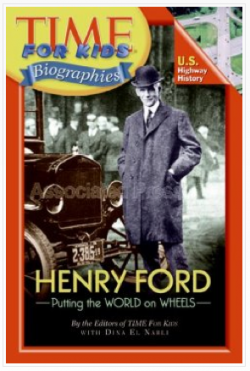 Henry Ford: Putting the World on Wheels
Henry Ford: Putting the World on Wheels
by Time for Kids Magazine Editors with Dina El Nabli
(HarperCollins, 2008)
Publisher Summary As a young boy, Henry Ford was fascinated by technology and how objects worked. His childhood interests led him to leave the Ford family farm in Michigan in search of a career with machinery, and the rest is automotive and economic history…Henry Ford made cars affordable, turning them into the primary means of travel for Americans. His innovations, including the assembly line, are still benefiting us today.
Make Way for Books This early-reader biography is well-designed with text, photos, posters, and ads establishing the essence of Henry Ford’s era. Sidebars with incidental trivia highlight interesting connections, including his friendship with Thomas Edison. The story is realistic and feels timeless because of the character traits used to shape its telling—hard work, inquiry, persistence, experience, and vision—transcend eras. This inspires big thinking.
Did you know Helen Keller and Henry Ford were contemporaries? Check out History’s Stories, our literary timeline to see what other important figures may have crossed their paths.
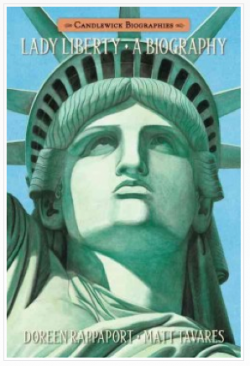 Lady Liberty: A Biography
Lady Liberty: A Biography
by Doreen Rappaport, illustrated by Matt Tavares
(Candlewick, 2014)
Publisher Summary A powerfully moving, authentic portrait of the Statue of Liberty, told through the eyes of those who created her and illustrated in glorious detail.
Soon America will be one hundred years old. I share my dream of a birthday gift.
It begins in 1865 as a romantic idea, but ten years later Édouard Laboulaye’s dream catches fire and takes shape. Sculptor Auguste Bartholdi gives the dream the form of a lady, holding a torch to “enlighten the world.” Engineers, plasterers, carpenters, coppersmiths—many of them immigrants—work together to turn the lady into a monument over 100 feet tall. Joseph Pulitzer calls on readers to help fund a pedestal, and hundreds send in nickels, dimes, and even roosters for the cause. Doreen Rappaport’s historically accurate, poetic vignettes and Matt Tavares’s magnificent images remind us of the true origins of a national symbol—and show that it took a lot of people to make the Lady.
Make Way for Books Much more than the statue’s history, this series of vignettes told in free verse reveal perspectives, personalities, and events leading up to the dedication of Lady Liberty. The quality of writing and illustration surpass many other books that address the story of the statue.
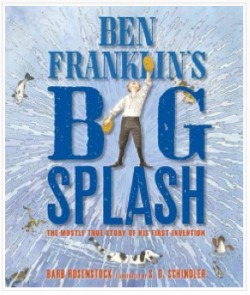 Ben Franklin’s Big Splash: The Mostly True Story of His First Invention
Ben Franklin’s Big Splash: The Mostly True Story of His First Invention
by Barb Rosenstock, illustrated by S.D. Schindler
(Perseus, 2014)
Publisher Summary Every inventor has to start somewhere, and one of the greatest innovators in our history was no exception. Ben Franklin developed his first invention while doing what he loved best: swimming! Ben Franklins’s Big Splash is the story of Franklin’s first invention, his journey through the scientific method, and the surprising successes that results when you’re willing to make mistakes. Barb Rosenstock’s rhythmic, whimsical style is the perfect complement to S. D. Schindler’s pen and ink and watercolor illustrations. Together they recreate history in an engaging and unique way. Both author and illustrator worked closely with Franklin experts; the book includes Franklin quotes, an extensive author’s note, timeline, and bibliography.
Make Way for Books A remarkable read, this story showcases a young Ben Franklin with the curiosity and confidence that would make him a famous inventor. Engaging from the very beginning, this story allows young readers to connect with Benjamin Franklin in new ways and invites them to look into the choices that allowed him to confidently enjoy inventing, even when his inventions failed. Featuring an afterward full of illustrated facts, a timeline, and excerpts from Franklin’s own journal, this is a biography that entertains and instructs.
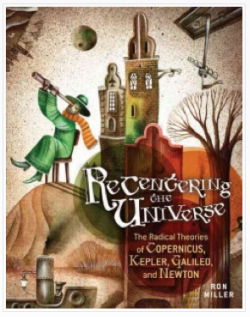 Recentering the Universe: The Radical Theories of Copernicus, Kepler, Galileo, and Newton
Recentering the Universe: The Radical Theories of Copernicus, Kepler, Galileo, and Newton
by Ron Miller
(Lerner, 2013)
Publisher Summary This title shows how a group of European scientists, in the span of roughly 150 years (early 1500s to the mid-1600s) worked through direct observation, overturning the centuries’ old accepted view of a geocentric universe. Through their research and writings, they proposed and described a new order of things in which the Earth orbits the Sun. In so doing, these scientists–Nicolaus Copernicus, Johannes Kepler, Tycho Brahe, Galileo Galilei, and Isaac Newton–challenged the accepted wisdom of the ages, specifically that of the Catholic Church. Galileo was accordingly tried and condemned to house arrest in 1633; the works of many others were banned. Not until the late 1900s did the Church revisit the Galileo case, ultimately concluding that it had made a mistake in suggesting that humans must accept biblical cosmology in literal terms.
Make Way for Books A factual, fair, and fascinating exploration of the scientific shift from and earth-centered models to sun-centered models of the universe. Well-written for middle-grade readers.



